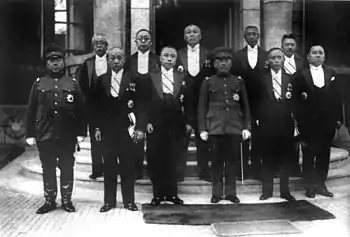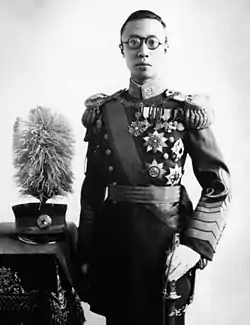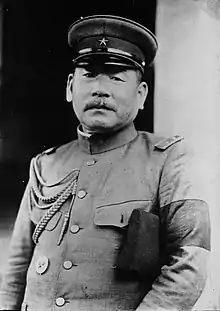Politics of Manchukuo
Manchukuo was a puppet state set up by the Empire of Japan in Manchuria which existed from 1931 to 1945. The Manchukuo regime was established four months after the Japanese withdrawal from Shanghai with Puyi as the nominal but powerless head of state[1] to add some semblance of legitimacy, as he was a former emperor and an ethnic Manchu.

Rear row, from left: Yuan Jinkai (袁金铠), Minister of Palatine affairs; Li Shaogeng (李绍庚), Minister of traffic; Ruan Zhenduo (阮振铎), Minister of education; Zhang Yanqing (张燕卿), Minister of foreign affairs.
Government
Manchukuo was proclaimed a monarchy on 1 March 1934, with former Qing dynasty emperor Puyi assuming the Manchukuo throne under the reign name of Emperor Kang-de. An imperial rescript issued the same day, promulgated the organic law of the new state, establishing a Privy Council, a Legislative Council and the General Affairs State Council to "advise and assist the emperor in the discharge of his duties". The Privy Council was an appointive body consisting of Puyi's closest friends and confidants, and the Legislative Council was largely an honorary body without authority. The State Council was therefore the center of political power in Manchukuo.
Political parties and movements
During his administration, the Kangde Emperor, in an interview with foreign journalists, mentioned his interest in forming a political party with Confucian doctrines. The Japanese "native" establishment, however, organized some right-wing and nationalist parties, in the Militarism-Socialism mould. Such movements, which had official status, were:
- Concordia Association (State-sponsored political party)
- Northeast Administrative Committee (Manchukuo nationalist local party)
- Russian Fascist Organization (the White Russian fascist association in Manchukuo)
- White Russian Fascist Party (later the Russian Fascist Party; White Russian anticommunist party in Manchukuo, used the swastika as symbol, guided by a Russian fascist "Duce")
- Bureau for Russian Emigrants in Manchuria (BREM) led by General Vladimir Kislitsin
- Monarquic Party (White Russian Tsarist Monarchic party with Japanese approval)
- Betarim Jew Zionist Movement (Jewish rights movement in Manchukuo)
- Far Eastern Jewish Council (Jewish Zionist council in Harbin, Manchukuo led by Dr. Abraham Kaufman, with Japanese Army support)
Notable people
The Imperial Manchu Court

- Aisin Gioro Henry Puyi (Kangde Emperor and head of state)
- Elizabeth Wanrong (Empress and first wife of the Kangde Emperor)
- Prince Aisin Gioro Pujie (brother of Puyi, possible heir of Manchukuo Throne)
- Prince Aisin Gioro Puren (brother of Puyi)
- Prince Aisin Gioro Yuyan (nephew of Puyi)
- Hiro Saga (Japanese sister-in-law of the Kangde Emperor)
- Wenxiu (first concubine of the Emperor)
- Tan Yuling (2nd Wife of the Kangde Emperor)
- Li Yuqin (4th Wife of the Kangde Emperor)
- Princess Aisin Gioro Huisheng (daughter of Pu-Chieh and Hiro Saga)
- Princess Aisin Gioro Xianyu (distant relative)
Others (local)
- Zheng Xiaoxu, prime minister
- Zhang Jinghui, next prime minister until 1945
- Xi Xia (Xi Qia), cabinet minister
- Ma Zhanshan, former warlord, and cabinet minister
- Xie Jishi, cabinet minister
- Zang Shiyi, cabinet minister
- Zhang Yangqing, cabinet minister
- Yu Zhishan, cabinet minister
- Yuan Jinkai, cabinet minister
- Lü Ronghuan, cabinet minister
- Ding Jianxiu, cabinet minister
- Li Shaogeng, cabinet minister
- Ruan Zhenduo, cabinet minister
- Ling Sheng, cabinet minister
- Sun Qichang, cabinet minister
- Bao Guancheng, Manchukuo's first ambassador in Tokyo[2]
- Yuan Cheng-Tse, Manchukuo ambassador in Tokyo
- Li Shao-Keng, Manchukuo ambassador in Tokyo
- Gen. Tinge, Manchukuo diplomat in Tokyo
- Lu Yiwen, Manchukuo ambassador in Berlin
Kwantung Army
- Commanders
| No. | Commander | Took office | Left office | Time in office | |
|---|---|---|---|---|---|
| 1 | General Shigeru Honjō (1876–1945) | 1 August 1931 | 8 August 1932 | 1 year, 7 days | |
| 2 | Field Marshal Nobuyoshi Mutō (1868–1933) | 8 August 1932 | 27 July 1933 † | 353 days | |
| 3 | General Takashi Hishikari (1871–1952) | 29 July 1933 | 10 December 1934 | 1 year, 134 days | |
| 4 | General Jirō Minami (1874–1955) | 10 December 1934 | 6 March 1936 | 1 year, 87 days | |
| 5 | General Kenkichi Ueda (1875–1962) | 6 March 1936 | 7 September 1939 | 3 years, 185 days | |
| 6 | General Yoshijirō Umezu (1882–1949) | 7 September 1939 | 18 July 1944 | 4 years, 315 days | |
| 7 | General Otozō Yamada (1881–1965) | 18 July 1944 | 11 August 1945 | 1 year, 24 days |
- Chief of Staff
- Koji Miyake (10 August 1928 – 8 August 1932)
- Kuniaki Koiso (8 August 1932 – 5 March 1934)
- Juzo Nishio (5 March 1934 – 23 March 1936)
- Seishirō Itagaki (23 March 1936 – 1 March 1937)
- Hideki Tōjō (1 March 1937 – 30 May 1938)
- Rensuke Isogai (18 June 1938 – 7 September 1939)
- Jo Iimura (7 September 1939 – 22 October 1940)
- Heitarō Kimura (22 October 1940 – 10 April 1941)
- Teiichi Yoshimoto (10 April 1941 – 1 August 1942)
- Yukio Kasahara (1 August 1942 – 7 April 1945)
- Hikosaburo Hata (7 April 1945 – 11 August 1945)
Others (Japanese)
- Chu Kudo, Chamberlain, aide-de-camp to Emperor Puyi
- Yoshioka Yasunori Army senior staff officer and Attaché to the Imperial Household in Manchukuo
- Kenjiro Hayashide official Kangde emperor biographer and author of "Epochal Journey to Japan"
- Chiune Sugihara, Vice Foreign Minister
- Hoshino Naoki, Vice Minister of Finance
- Kenji Doihara, Japanese spymaster and military commander
- Norihiro Yasue, Army officer, author of the Fugu Plan
- Koreshige Inuzuka, Navy officer, co-author of the Fugu Plan
- Masahiko Amakasu, Vice Minister of Civil Affairs and head of Manchukuo Film Association
- Yoshisuke Aikawa, prominent industrialist
- Tatsunosuke Takasaki, prominent businessman
- Toranosuke Hashimoto, State Shinto head priest
- Yanagida Genzo Commander, Kwantung Defense Command
- Takashi Hishikari Kwantung Army ambassador to Manchukuo.
- Kimio Miyagawa Japanese Consul-general in Harbin
- Funao Miyakawa Japanese General Counselor in Vladivostok and then in Harbin
- Prince Fumitaka Konoe Army Senior Lieutenant, son and personal secretary of Prince Fumimaro Konoe
- Shun Akifusa Chief of military Mission in Harbin and political adviser to the white Russian political groups in same city
- Genzo Yanagita head of the Japanese military mission in Harbin
- Kenji Ishikawa head of a sabotage group of that mission
- Yutaka Takeoka intelligence officer and head of the Dairen military mission
- Saburo Asada head of the 2nd (Intelligence) department of the staff of the Kwantung Army
- Tamaki Kumazaki deputy chief of intelligence of Kwantung Army
- Hiroki Nohara deputy chief of Kwantung Army Intelligence
- Yoshio Itagaki deputy chief of Kwantung Army Intelligence and son of Seishiro Itagaki, war minister from 1938–1939
Others
- Genrikh Lyushkov, ex-Soviet Far East NKVD defector, adviser to Kwantung Army
- Konstantin Vladimirovich Rodzaevsky, White Russian anticommunist leader
- General Kislitsin, another White Russian anticommunist chief
- Abraham Kaufman, founder of Far Eastern Jewish Council and Betarim Jew Zionists Movement
- Trebitsch Lincoln, Hungarian pro-Japanese collaborator
- August Ponschab, German consul in Harbin, Manchuria
- Auguste Ernest Pierre Gaspais, Vatican representative in Harbin, Manchuria
- Charles Lemaire, Vatican diplomatic officer in Harbin, Manchuria
- Lian Yu, ambassador from the Japanese-sponsored Nanjing Nationalist Government
- Mariano Amoedo Galarmendi, Spanish chargé d'affaires to 1939
- Fernando Valdés Ibargüen, Count of Torata, Spanish minister 1941 to 1942
- José González de Gregorio y Arribas, Spanish chargé d'affaires 1942 to 1943, commercial attaché since 1940
References
- Taylor, Anne; Hopper, Stephen (1988). The Banksia Atlas (Australian Flora and Fauna Series Number 8). Canberra: Australian Government Publishing Service. ISBN 0-644-07124-9.
- "Manchukuo Diplomat Puts Naive Scheme", The Straits Times, 1932-10-11, retrieved 2011-08-05
Ebrey, Patricia Buckley (1996), The Cambridge Illustrated History of China, New York, pp. 282, doi:10.2277/052166991X, ISBN 0-521-66991-X





.jpg.webp)
